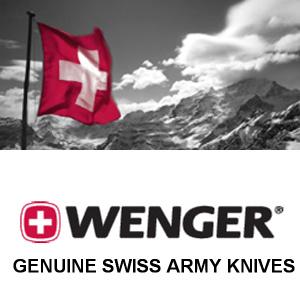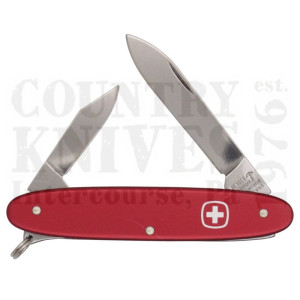Wenger
Wenger is known as the maker of "The Genuine Swiss Army Knife", and their history is strongly linked to the history of the Swiss Army knife.
Dating back to 1886, the Swiss Army decided to equip every soldier with a regulation single-blade folding knife. In 1889, a new rifle was introduced. To disassemble the rifle, a screwdriver was needed. So a decision was made to create a multi-purpose tool incorporating a knife, screwdriver, reamer and can-opener – the Swiss Army Knife was born. At that time, the cutlery industry in Switzerland was well established, but incapable of mass production so the initial knives were made in Solingen, Germany. In 1891, Karl Elsener (Victorinox) established the Association of Swiss Master Cutlers. As a result, he is able to deliver the first major supply of to the Swiss Army. Two years later, the Swiss cutlery company Paul Boéchat & Cie, which later became Wenger, received its first contract from the Swiss military to produce Modell 1890 knives.
In 1895, a group of entrepreneurs from Delemont bought Boéchat and built a new plant at Courtetelle. About two years later, Theodore Wenger was hired to be its General Manager. The son of a pastor, Theodore Wenger was a minister who had served in the United States. One of Wenger’s first acts was to acquire a manufacturer of spoons and forks, which he moved to a rented factory in Delemont. Then in 1900, he built a new 18,000 square foot facility there. Both the utensil operations and the Courtetelle cutlery production were incorporated into the new plant now called Fabrique Suisse de Courtetelle at Services. A few years later, Wenger acquired Fabrique Suisse, renamed it Wenger et Cie. and shepherded its growth for the next forty years.
The company from which Wenger emerged had been a supplier to the Swiss Army since 1893 and is located in the French-speaking Jura region and its competitor (Victorinox) is in the German-speaking canton of Schwyz. To avoid friction between the two cantons, the Swiss Government decided in 1908 that the two companies would split the contract, providing knives to the Swiss Army from 1908 until Victorinox acquired Wenger in 2005.
Both companies, Paul Boéchat (Wenger) and Elsener (later to become Victorinox), used the cross and shield to identify their knives–a symbol still used today. While Wenger touted itself as the “Genuine Swiss Army Knife,” Victorinox laid claim to being the “Original Swiss Army Knife.” In any case, both have been manufacturing Swiss Army Knives for over 100 years and both must meet identical specifications defined by the Swiss Army. Interestingly, the term "Swiss Army Knife" was coined by US Servicemen in World War II. The name proved to be much more marketable than the original name "Offiziersmesser."
In 2005, Wenger was acquired by rival Victorinox. Since 2013, Wenger Swiss Army knives are integrated into the Victorinox collection.




